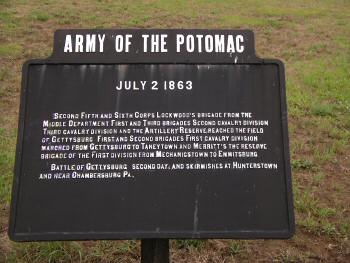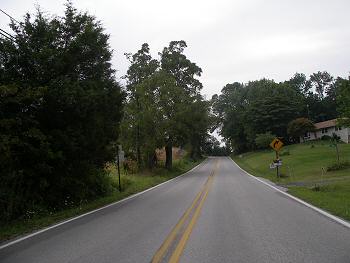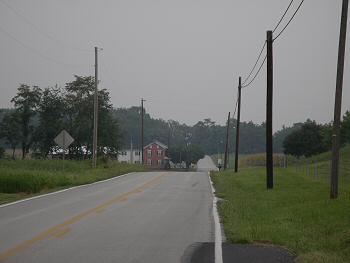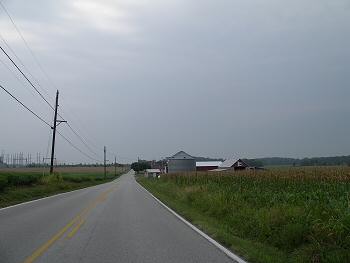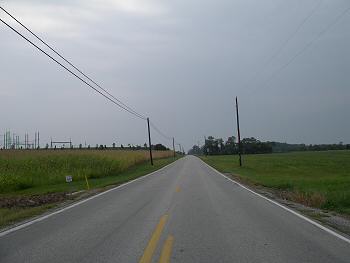|
Hunterstown:
North Cavalry Field of Gettysburg
By Troy Harman, National Park Ranger and Historian
Gettysburg National Parks Service
Hunterstown Cavalry Battlefield, also known as North Cavalry Field, is a
National Shrine waiting to be fully appreciated and brought into the fold
of sacred places visited regularly by patrons of Gettysburg National
Military Park. Fields and barns to either side of the
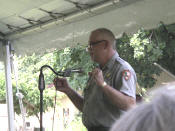 Hunterstown road,
just to the south of old town square mark the site of a significant
cavalry fight waged there after 4:00 PM on July 2, 1863. Union
participants involved were Michigan Troopers under Brigadier General
George Armstrong Custer versus the Confederacyís famous Cobbís Georgia
Legion, with support from Phillips Georgia Legion, the 2nd South Carolina
Cavalry and 1st North Carolina Cavalry. They were under the overall
direction of the capable Brigadier General Wade Hampton, who latter
replaced J.E.B. Stuart as Robert E. Leeís cavalry chieftain. Hunterstown road,
just to the south of old town square mark the site of a significant
cavalry fight waged there after 4:00 PM on July 2, 1863. Union
participants involved were Michigan Troopers under Brigadier General
George Armstrong Custer versus the Confederacyís famous Cobbís Georgia
Legion, with support from Phillips Georgia Legion, the 2nd South Carolina
Cavalry and 1st North Carolina Cavalry. They were under the overall
direction of the capable Brigadier General Wade Hampton, who latter
replaced J.E.B. Stuart as Robert E. Leeís cavalry chieftain.
Lines of battle were established a mile apart with Custerís men
establishing their artillery at Felty-Tate Ridge on the northern end, to
oppose Hamptonís rebel guns atop Brinkerhoffís Ridge directly south. In
the valley between, a fierce hand-to-hand fight would ensue across the J.G.
Gilbert and J. Felty Farms, intact to the present day. It began with
Custer ordering elements of the 6th and 7th Michigan cavalry to dismount
and move south on foot beyond and below the ridge, along both sides of the
Hunterstown Road. Concealed by fields carpeted with ripe golden wheat, the
Michigan troopers waded inconspicuously forward to the Felty Farm where
some of their best marksmen found excellent cover and elevated fields of
fire within the enormous Pennsylvania bank barn west of the road. Feltyís
barn was even large enough to conceal Lieutenant A.C.M. Penningtonís 2nd
U.S. Battery M, 250 yards to the north along the Felty-Tate ridge.
Meanwhile, to complete the deployment, dismounted men of the 7th Michigan
formed undetected in the tall wheat east of the Hunterstown Road, to form
a cross fire with the 6th Michigan.
Custer had arranged the perfect trap, but how to lure Confederate
cavalrymen into it required another step. To achieve this and complete the
perfect ambush, he would personally lead around sixty mounted men of
Company A, 6th Michigan on a daring charge toward the Confederate
position. Because the Hunterstown Road was tightly flanked on both sides
with post and rail fences, it was impossible for more than one company to
move at a gallop. Recognizing this, Custer would use Company A as a small
shock force to establish contact with southern troopers. After hitting
them hard to get their ire up, he retreated intentionally drawing them
back north to the prepared ambush waiting east and west of the Hunterstown
Road at Feltyís barn. Custer, a new brigadier nearly lost his life in the
initial charge in front of the Gilbert farm, where Confederates resisted.
If it had not been for Norville Churchillís timely rescue of Custer,
whisking him out of harmís way and onto his horse, later Indian Wars on
Western Plains may have taken on a different complexion.
In Kentucky Derby fashion, the horses of Cobbís Legion raced in the summer
air nose to tail with Company A, for a quarter mile up the narrow
Hunterstown Road, all-the-while bouncing between the fences which hemmed
them in like a bowling alley. So caught up in the chase were the
Georgians, that they fell like a hungry mouse right into the trap which
was released on them as soon as Union cavalry cleared the waiting
crossfire. Not being able to stop their horses in time, several
Confederates raced beyond the barn where Penningtonís artillery opened at
close range, killing five rebel officers. Between the two sides, eleven
officers were killed or wounded, indicating the short struggle was
vicious. Although statistics vary, the total losses at Hunterstown range
from eighty to one hundred men. Confederate survivors withdrew south down
the Hunterstown Road to the Gilbert Farm and subsequently Brinkerhoffís
Ridge. With both sides monitoring the other from a mileís distance, only
long range artillery was exchanged the rest of the evening. At 11:00 PM,
Judson Kilpatrick withdrew Custerís men and the rest of the division with
new orders to the Baltimore Pike.
The significance of this action far exceeds the fight itself, and the
ramifications were greater than many realize. The first of these has to do
with Culpís Hill being saved for the Union on July 2. When Custer enticed
Hamptonís Georgia and South Carolina Cavalrymen into a fight, he prevented
them from reaching the left flank of the Army of Northern Virginia by way
of the Hunterstown Road. Jeb Stuart had ordered them there to protect
Richard Ewellís left, while the latter assaulted Culpís Hill. When Stuart
learned of Union Cavalry at Hunterstown, he countermanded his original
order, to permit Hampton to stay and fight. Ewell has been criticized
greatly for not beginning his attack at Culpís Hill earlier on July 2, but
his delay in part was related to Hamptonís cavalry not arriving to protect
him from David Greggís division of Union cavalry sitting squarely on his
flank along the Hanover Road. To compensate, Ewell had to reassign 3,000
officers and infantrymen to the Hanover Road. This weakened his main
assault upon Culpís and Cemetery Hills. Indirectly then, the episode at
Hunterstown helped to save the Army of the Potomac's main position at
Gettysburg.
Another great consequence of Hunterstown is that Daniel Sickles Union
Third Corps, representing the left flank of that army near the Round Tops,
was largely unprotected by cavalry. Outside of one or two cavalry units
doing spot duty there, the Federal flank was vulnerable. This is so
because the Signal Station at Little Round Top incorrectly reported
between 1:30 PM and 1:45 PM on July 2, to have spotted a column of 10,000
Confederates with trains to be marching towards the extreme Union right.
What they actually saw was James Longstreetís countermarch moving
northeast before turning due south. Union Army Headquarters responded by
giving David Gregg orders to take some of his cavalry north from Hanover
Road towards Hunterstown and Heidlersburg to ascertain whether the large
Confederate column was coming through by way of modern Route 394 to
assault Culpís Hill and Meadeís lines of communication and supply below on
the Baltimore Pike. Judson Kilpatrickís Cavalry division was given this
assignment by Gregg. When Custer struck Hampton at Hunterstown, he was
actually trying to ascertain whether a column of 10,000 Confederate
Infantry lay beyond.
Had the Round Top Signal Station not crossed its signals, Kilpatrickís
division with Custer most likely would have moved to protect Sicklesí
left. Such a result should have erased the Meade-Sickles controversy,
because Kilpatrickís men naturally would have discovered, harassed, and
delayed Longstreetís men until Commanding Union General Meade rectified
Sicklesí line. Because Longstreetís Corps was without cavalry on July 2,
Sickles with Kilpatrickís help promised a decided advantage for the
federals on July 2. Circumstances in Hunterstown sidetracked this logical
scenario. There are many other historical points
to make about Hunterstown such as its early status as a rival with
Gettysburg for the county seat, a stopping point for President George
Washington during the Whiskey Rebellion of 1793, an important early
crossroads town, and site of a substantial Confederate hospital.
Regarding the hospital connection, the old town is still filled with the
charm of a late 1700ís hamlet, untouched thus far by modern development.
Quaint homes and settings undisturbed, harkening back to another time
include Kilpatrickís Headquarters at the Grass Hotel, the John Tate House,
Barn & Blacksmith Shop where George Washington shod his horseís shoes in
October 1793. One of the Tate sheds even bears artillery shell marks left
from the cavalry battle in 1863. The Great Conewago Presbyterian Church is
another impressive structure from the period, made of stone, and
documented as a Confederate Hospital. Each of these dwellings adds so much
to the historic time capsule that is Hunterstown, Pennsylvania.
With that said, every effort must be made to preserve the principle
battlefield at Hunterstown along with the charm and richness of the old
town sitting directly north of it. As development comes to Hunterstown, it
must tastefully build around the two and save both. Doing so is not only
imperative with respect to its National Register of Historic Places
status, but it is also wise. If developed right, all Hunterstown property
owners can boast a preserved national shrine in the heart of their town
that will only increase in monetary and cultural value.
Finally, as the July 3 cavalry fight, three miles east of Gettysburg, is
widely known today as East Cavalry Field; and as the ill-fated cavalry
charge led by Elon Farnsworth on July 3, two miles south of town, is
commonly called South Cavalry Field; so too should the Hunterstown clash,
only four miles north of Gettysburg be regarded as North Cavalry Field. In
this same vein, Bufordís cavalry fight one mile west of town on July 1
might be called West Cavalry Field. In all of these actions, Union cavalry
buffered key Union positions in four directions of the compass. Each site
is equally essential to accurately portraying Gettysburg as the most
famous battle for human freedom in American History. |
